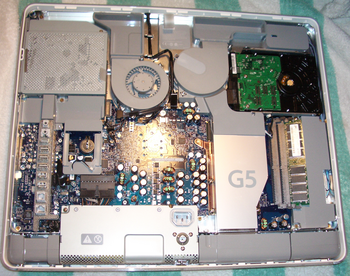
The internals of the original 20″ iMac G5. Many hardware components can be seen. (Photo credit: Wikipedia)
In an effort to market its desktop computers for the “it’s good enough” set, Apple has quietly demonstrated a willingness to reduce the price of its iMac.
This would be big news except for the fact that along with the somewhat lower price point comes an iMac whose performance is throttled accordingly. Also, even if the computer itself ends up being good enough for entry level consumers, the price drop hardly is.
The Cupertino giant has never been one to try to compete in the entry level computer space with respect to cost. They have offered “consumer” models like iMac, but these models were still kind of pricey compared to what could be had in the Windows world for the same cash outlay.
The rain and the classical music I am listening to has made me drift over to Apple’s online store. Instead of only viewing the 21.5″ Apple refurbished iMac a couple of years old for $1,199 ($300 savings), I also looked at the new 21.5″ iMac for $1,099 (regular price).
Apple is playing an interesting game here. Of course it still has stock of last year’s model (and beyond) it wishes to unload. It lowers the price on refurbished models. I have always urged clients and friends alike to look for Apple refurbished Macs for some of the best deals.
In my opinion, the specs on this particular refurbished iMac makes it clearly the choice if one is seeking purely the best performance (between this one and the less expensive, brand new iMac). Apple’s marketing department understands that entry level consumers considering a new iMac will opt for the cheaper (I can only say “less expensive” so many times), less powerful and less roomy hard drive in the $1,099 iMac.
Whether they state it outright or not, Apple is selling to this market segment–those seeking a new, cheaper iMac that performs just/only well enough. This is the demographic Apple caters to with its underwhelmingly spec’d all-in-one.
This scenario harkens back to the time I paid $1,999 for a logic-board crippled, new Mac Performa 5215 CD because it was all the new Mac I could afford in 1995. Good enough in that case, turned out to be just the opposite. I quickly grew out of the computer, but not before learning a great deal about how to optimize one whose design was clearly flawed.
Since moving to the Intel family of processor chips, Apple has been careful not to repeat the mistake of selling severely underperforming computers (relative to the rest of its line). The new $1,099 iMac is surely capable for most users. But with each revision of Mac operating system that Apple releases, the $1,099 iMac will seem slower and slower. And there really won’t be anything for consumers to do once they crave more speed and power except to drop more cash on another cheap (for Apple) iMac in three years’ time or less.
I not too long ago suggested Apple drop the price of its Mac Mini to $399 to generate some interest in the entry level space it only halfheartedly serves. This hasn’t happened. Sadly, starting at $599, the Mac Mini is not a good value when you factor in its “bring your own peripherals” (monitor, keyboard, mouse) party approach.
What would be a good deal?
In this world where it’s becoming increasingly difficult for not only Apple, but all hardware companies to stay original and new when it comes to innovating, I suggest doing as Hollywood does: make a sequel or at least a remake of a movie that was big box office when first released.
Their are only so many chords you can use when it comes to songwriting. The pressure to stay at the cutting edge is always on Apple more so than any other company.
iMacs took the world by storm in their original CRT versions. They are even more popular today with their Intel processors and streamlined, thin, sexy designs that pack ten pounds of components into five pound sacks. Heat is the enemy of computers. iMacs, like their MacBook Pro brethren generate a lot of it. Since they are all in one designs, iMacs have to be brought to the shop when something inside quits. This is the downside to all that sexiness one pays for.
If Apple were serious about going after some of the enterprise they’d offer an upgradeable tower at $899 and with specs just below the entry level iMac.
Towers were and are still being used by Mac and PC users alike. One of the best things about my Sawtooth is how easy it is to open up, upgrade and work on. We know opening up the case on a new Mac voids its warranty. But a potential whole new, younger market segment might be willing to try an Apple tower just to drive it for a year, then see about opening it up, upgrading it and falling in love with it all over again. Once the Mac Mini or iMac breaks down, only a costly trip to the shop can save it as repair is too daunting for the average user.
An affordable-to-the-masses, upgradeable Mac tower sequel, may attract an entirely new legion of fans to the Mac much like the one that is currently graying.
People hold on to older technology because it serves them. Computers like towers are highly upgradeable. Computers that can’t be (easily) upgraded are disposable and don’t foster the kind of brand loyalty that Apple has worked so hard over the years to maintain. The foolish goal of forcing consumers to buy practically impossible-to-upgrade iMacs every two and one-half to three years just makes Apple seem like all the rest.





